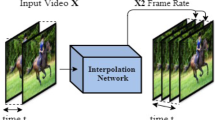Abstract
Virtual reality 360° video has an ultra-high resolution (usually 4–8 K), which takes more coding time than traditional video. Considering the degree of horizontal stretching in a different area of the ERP projected video, a fast coding unit (CU) partition algorithm based on the sum of region-directional dispersion is proposed. The relationship between the current block and its adjacent ones is measured based on the degree of horizontal stretching, and the current frame is divided into three regions. A new metric named the Sum of Region-directional Dispersion is defined to measure the complexity of the current block in different regions and directions. In the proposed algorithm, the optimal fast partition threshold is determined for each region to achieve the goal of early termination partition. Compared with the original reference software HM16.20, the proposed algorithm can reduce the time in virtual reality video coding by 38.5%, while the BD-rate only increases by 0.40%.













Similar content being viewed by others
References
P. P. Routhier: Virtually perfect: factors affecting the quality of a VR experience and the need for a VR content quality standard, in SMPTE 2016—Annual Technical Conference and Exhibition, pp. 1–20, (2016)
G. X. Jin, S. Ankur, B. Madhukar: Motion estimation and compensation for fisheye warped video, in International Conference on Image Processing, pp. 2751–2755, (2015)
Ralf, S., et al.: Interactive steaming of panoramas and VR worlds. SMPTE Motion Imaging J 126, 35–42 (2017)
Y. Ramin Ghaznavi et al.: Efficient coding of 360-degree pseudo-cylindrical panoramic video for virtual reality applications, in International Symposium on Multimedia, pp. 525–528, (2016)
Li, Z.M., et al.: A fast CU partition method based on CU depth spatial correlation and RD cost characteristics for HEVC intra coding. Signal Process. Image Commun. 75, 141–146 (2019)
Chen, F., et al.: Fast intra coding algorithm for HEVC based on depth range prediction and mode reduction. Multimedia Tools Appl. 77, 28375–28394 (2018)
Liao, W.H., Chen, Z.Z.: A fast CU partition and mode decision algorithm for HEVC intra coding. Signal Process. Image Commun. 67, 140–148 (2018)
F. Y. Duanmu et al.: Hybrid cubemap projection format for 360-degree video coding, in 2018 Data Compression Conference, (2018)
N. Yu et al.: Improving cube-to-erp conversion performance with geometry features of 360 video structure, in 2019 Data Compression Conference, (2019)
Y. W. He et al., “Content-Adaptive 360-Degree Video Coding Using Hybrid Cubemap Projection,” 2018 Picture Coding Symposium, 2018
K. K. Sreedhar et al.: Standard-compliant multiview video coding and streaming for virtual reality applications, in 2016 IEEE International Symposium on Multimedia, (2016)
J. Sauer et al.: Geometry-Corrected Deblocking Filter for 360° Video Coding using Cube Representation, in 2018 Picture Coding Symposium, (2018)
I. Storch et al.: FastIntra360: a fast intra-prediction technique for 360-degrees video coding, in 2019 Data Compression Conference, (2019)
M. M. Zhang et al.: Fast PU early termination algorithm based on WMSE for ERP video intra prediction, in 2019 Data Compression Conference, (2019)
X. H. Guan et al.: Fast early termination of CU partition and mode selection algorithm for virtual reality video in HEVC, in 2019 Data Compression Conference, pp. 576, (2019)
T. M. Li, J. Z. Xu, Z. Z. Chen: Spherical domain rate-distortion optimization for 360-degree video coding, in International Conference on Multimedia and Expo, vol. 0, pp. 709–714, (2017)
Y. B. Wang et al.: A fast intra prediction algorithm for 360-degree equirectangular panoramic video, in Visual Communications and Image Processing, vol. 2018, pp. 1–4, (2018)
F. X. Yang et al.: Region priority based adaptive 360-degree video streaming using DASH, in International Conference on Audio, Language and Image Processing, pp. 398–405, (2018)
F. Takuya et al.: Graceful quality improvement in wireless 360-degree video delivery, in IEEE Global Communications Conference, (2018)
H. Philippe et al.: 360-degree video quality evaluation, in 2018 Picture Coding Symposium, pp. 328–332, (2018)
A. Abbas, B. Adsumilli: AHG8: new GoPro test sequences for virtual reality video coding, in Joint Video Exploration Team (JVET) of ITU-T SG 16 WP 3 and ISO/IEC JTC 1/SC 29/WG 11, 4th Meeting, document JVET-D0026, Chengdu, China, (2016)
E. Asbun, Y. He, Y. Ye: AHG8: InterDigital test sequences for virtual reality video coding, in Joint Video Exploration Team (JVET) of ITU-T SG 16 WP 3 and ISO/IEC JTC 1/SC 29/WG 11, 4th Meeting, document JVET-D0039, Chengdu, China, (2016)
S. Schwarz, A. Aminlou: Tampere pole vaulting sequence for virtual reality video coding, in Joint Video Exploration Team (JVET) of ITU-T SG 16 WP 3 and ISO/IEC JTC 1/SC 29/WG 11, 4th Meeting, document JVET-D0143 Chengdu, China, (2016)
W. Sun R. Guo: Test sequences for virtual reality video coding from letinvr, in Joint Video Exploration Team (JVET) of ITU-T SG 16 WP 3 and ISO/IEC JTC 1/SC 29/WG 11, 4th Meeting, document JVET-D0179, Chengdu, China, (2016)
Bai, H.H., et al.: Multiple description video coding based on human visual system characteristics. Trans. Circuits Syst. Video Technol. 24, 1390–1394 (2014)
Li, Z., Zhao, Y., Dai, Z., Rogeany, K., Cen, Y., Xiao, Z., Yang, W.: A fast CU partition method based on CU depth spatial correlation and RD cost characteristics for HEVC intra coding. Signal Process. Image Commun. 75, 141–146 (2019)
Belghith, F., Kibeya, H., Ayed, M., Masmoudi, N.: Fast coding unit partitioning method based on edge detection for HEVC intra-coding. Signal Image Video Process 10, 811–818 (2016)
Acknowledgements
This work is supported by the Great Wall Scholar Project of Beijing Municipal Education Commission (CIT&TCD20180304), Beijing Municipal Natural Science Foundation (No. 4202018), and the National Natural Science Foundation of China (No. 61972023).
Author information
Authors and Affiliations
Corresponding authors
Additional information
Publisher's Note
Springer Nature remains neutral with regard to jurisdictional claims in published maps and institutional affiliations.
Rights and permissions
About this article
Cite this article
Zhang, M., Wang, Y., Liu, Z. et al. A fast CU partition algorithm based on sum of region-directional dispersion for virtual reality 360° video. Multimedia Systems 28, 2079–2091 (2022). https://doi.org/10.1007/s00530-020-00679-0
Published:
Issue Date:
DOI: https://doi.org/10.1007/s00530-020-00679-0




